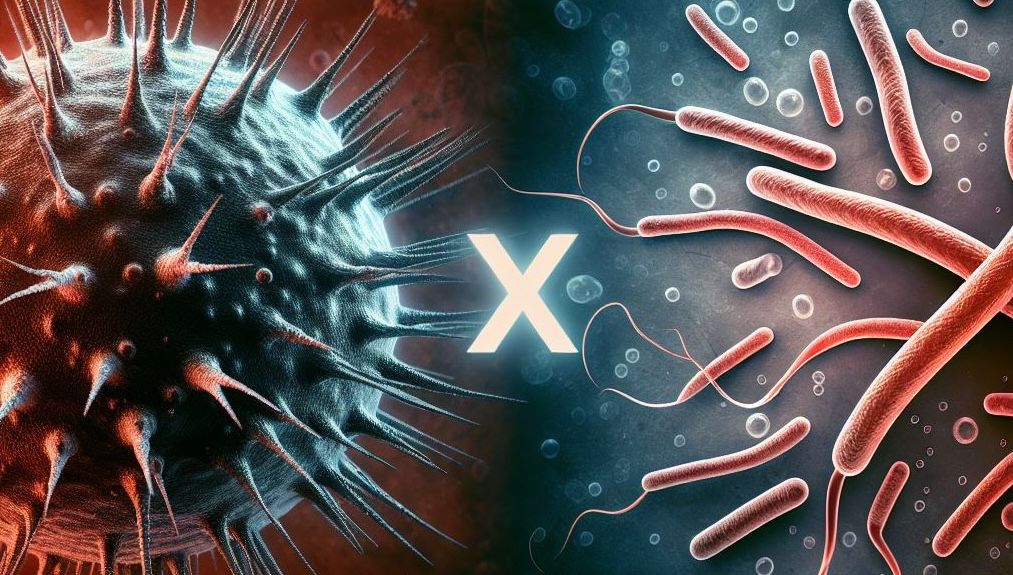“Disease X: Viral vs. Bacterial Threats – Which is More Dangerous?”
[The science and facts in this article on Disease X were reviewed and checked via Copilot – powered by ChatGPT]
The concept of “Disease X,” as defined by the World Health Organization (WHO), is an unknown hypothetical pathogen that could cause a future epidemic or pandemic. The COVID-19 pandemic, caused by the SARS-CoV-2 virus, exemplifies how a novel virus can rapidly spread globally, overwhelming healthcare systems and causing significant mortality.
Disease X can be broadly categorized into viral and microbial (bacterial) subtypes. Viral subtypes, highlighted by COVID-19, require host cells to replicate and often spread quickly through respiratory droplets. Bacterial subtypes, under-addressed compared to viral subtypes, can survive in various environments, including on surfaces and in moisture, making them resilient and capable of persisting outside a host. The risk of severe illness and rapid death in the event of a microbial Disease X is further compounded by the critical issue of increasing antibiotic-resistant infection cases in recent years, especially among COVID-19 patients, with reports indicating over 40% of the cases being diagnosed with drug-resistant bacterial co-infection (https://doi.org/10.1016/j.jinf.2024.106183).
Given these differences, it is crucial to conduct a comparative threat assessment to understand which type of hypothetical Disease X—viral or bacterial—might pose a greater risk in terms of global deaths over the next two years if it were to emerge today. This assessment will help prioritize resources and strategies for prevention, treatment, and containment.
Comparative Threat Assessment: Hypothetical Bacterial vs. Viral Disease X
Hypothetical Bacterial Disease X (Similar to Strep A with Antibiotic Resistance)
- Rapid Progression and High Mortality: This disease causes severe illness and death within 48 hours, leading to very high mortality rates in a short period.
- Antibiotic Resistance: Limited treatment options due to antibiotic resistance would result in many infections being untreatable, leading to higher mortality.
- Strain on Healthcare Systems: The rapid onset and severity would quickly overwhelm healthcare systems, especially those already strained by COVID-19.
- Vulnerable Populations: Individuals with compromised immune systems due to COVID-19 sequelae would be at higher risk of severe outcomes and death.
Hypothetical Viral Disease X
- High Transmissibility: Viral diseases often spread more rapidly and widely, potentially infecting a larger portion of the global population.
- Mutation Rates: High mutation rates could lead to new variants that may evade immunity, complicating control measures and prolonging the pandemic.
- Treatment Options: While broad-spectrum antivirals and steroids can help, the development and distribution of specific treatments and vaccines take time.
- Public Health Impact: The rapid spread and high mutation rates could lead to prolonged strain on healthcare systems and significant mortality, especially in populations with compromised immunity.
Comparative Assessment
- Bacterial Disease X: The immediate and severe nature of the bacterial Disease X, combined with antibiotic resistance and rapid progression, would likely result in very high mortality in a short period. The inability to effectively treat infections and the rapid onset of severe symptoms would lead to a high number of deaths, especially in vulnerable populations.
- Viral Disease X: While the viral Disease X could infect a larger number of people due to high transmissibility, the availability of broad-spectrum antivirals and steroids, along with ongoing vaccine development, could help mitigate some of the impact. However, the high mutation rates and potential for prolonged outbreaks could still result in significant mortality.
Conclusion
Given the current global context and the factors discussed, the bacterial Disease X with antibiotic resistance is likely to result in greater global deaths in the next two years if it started today. The rapid progression, high mortality rate, and limited treatment options due to antibiotic resistance make it an extremely dangerous threat, particularly for populations with compromised immune systems from COVID-19 sequelae. The viral Disease X’s dependency on host cells for replication and high mutation rates pose significant challenges but can be mitigated with effective antiviral treatments and vaccines. Additionally, vaccination approaches are generally less effective for bacterial diseases compared to viral diseases, further highlighting the complexity of addressing bacterial Disease X.
Proposed Active Countermeasures Against Disease X
Outside of social measures like lockdowns and paid sick leaves, several active countermeasures can significantly reduce the risk of infection and transmission of both viral and bacterial Disease X. These measures include the use of N95 masks, active disinfectant use for hands and surfaces, and frequent use of disinfectant-containing nasal sprays at suspected exposures.
- N95 Masking
| Effectiveness: Filters out at least 95% of airborne particles, providing high protection.
| Usage: Proper fitting and consistent use, especially in high-risk environments, are crucial. - Active Disinfectant Use for Hands and Surfaces
| Hand Hygiene: Regular use of alcohol-based hand sanitizers (≥60% alcohol) and handwashing with soap and water.
| Surface Disinfection: Regularly disinfect frequently-touched surfaces to prevent pathogen spread. - Disinfectant-Containing Nasal Sprays
| Povidone-Iodine (0.05%): Reduces viral and bacterial load in nasal passages without the nasal irritation at higher doses.
| Usage: Regular application, especially after potential exposure, can lower infection risk.
______________________________________________________________________________________
Additional Considerations
When comparing the key difference that viruses require host cells to replicate, while bacteria only need moisture to survive and proliferate, we find:
- Transmission: Bacteria’s ability to survive in various environments, including on surfaces and in moisture, makes them highly resilient and capable of persisting outside a host. This can lead to prolonged environmental contamination and increased transmission risk. Viruses, on the other hand, require host cells to replicate, making direct transmission between hosts essential.
- Virulence: Bacterial Disease X’s rapid progression and high virulence can lead to severe outcomes and high mortality, especially with antibiotic resistance. Viral Disease X’s high mutation rates can lead to new variants, complicating control measures and potentially increasing virulence and transmissibility.
- Treatment: Bacterial Disease X’s limited treatment options due to antibiotic resistance pose a significant challenge. Viral Disease X can be mitigated with broad-spectrum antivirals and steroids, but specific treatments and vaccines are crucial for long-term control.
- Public Health Impact: Bacterial Disease X’s environmental resilience and rapid progression can quickly overwhelm healthcare systems and require extensive decontamination efforts. Viral Disease X’s rapid spread and high mutation rates can lead to prolonged strain on healthcare systems and complicate public health responses.
Likelihood Analysis
While both viral and bacterial pathogens pose significant threats, the likelihood of the next Disease X being viral might be slightly higher due to several factors:
- Historical Precedence: Recent pandemics, such as COVID-19, H1N1 influenza, and HIV/AIDS, have been caused by viruses.
- High Mutation Rates: Viruses mutate rapidly, leading to new strains that can evade immunity and spread quickly.
- Zoonotic Potential: Many viruses originate from animals and can jump to humans, as seen with SARS, MERS, and Ebola.
However, the threat from bacterial pathogens, particularly those that are antibiotic-resistant, should not be underestimated. The rise in antibiotic resistance is a critical issue that could lead to severe outbreaks with high mortality rates.
Vaccine Effectiveness
Vaccination approaches would not be equally effective for both bacterial and viral Disease X scenarios:
- Viral Disease X: Vaccines for viral diseases are generally more effective due to the ability to target specific viral proteins (antigens). The success of vaccines for diseases like COVID-19, influenza, and measles demonstrates this effectiveness. Advances in vaccine technology, such as mRNA vaccines, allow for rapid development and deployment.
- Bacterial Disease X: Developing vaccines for bacterial diseases is more challenging due to the complexity and variability of bacteria. While there are effective vaccines for some bacterial diseases, many bacterial pathogens lack effective vaccines. The rise of antibiotic-resistant bacteria further complicates vaccine development and effectiveness.
Mortality
- Bacterial Disease X: Likely to result in very high mortality in a short period due to rapid progression, environmental resilience, and limited treatment options.
- Viral Disease X: Mortality could be high, especially if highly virulent and transmissible, but the availability of broad-spectrum antivirals and steroids can reduce mortality and improve recovery rates.
In summary, while both hypothetical Disease X scenarios present severe threats, the bacterial Disease X’s ability to survive in various environments and its rapid progression make it particularly dangerous. The viral Disease X’s dependency on host cells for replication and high mutation rates pose significant challenges but can be mitigated with effective antiviral treatments and vaccines.

